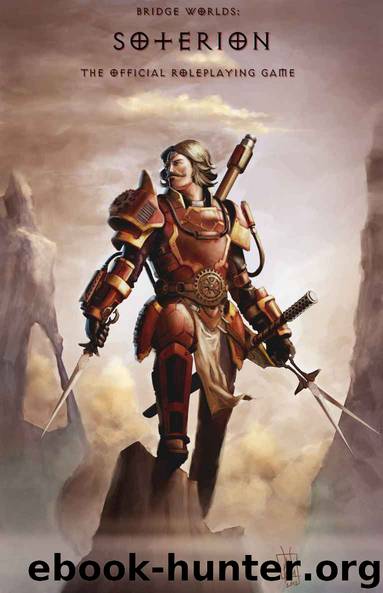Bridge Worlds: Soterion by Randy Blackwell & George Clark

Author:Randy Blackwell & George Clark [Blackwell, Randy]
Language: eng
Format: epub
Publisher: Lamplight Media
Published: 2013-05-13T07:00:00+00:00
If an attacking creature is large enough and the target creature is small enough, then the target may be grabbed and “crushed”. This follows the same progression as the “They Must Be Gi- ants” rule. A creature two size categories higher than the target may crush the target.
The grab is accomplished through the Brawling skill. Characters/creatures who do not have the Brawling skill fall within the performing unlearned skills rule. For the grab, any physical armor (such as leather armor) of the creature is not calculated in the defense. The attacking creature isn’t trying to get through the armor; he’s just trying to grab someone. If the attack is successful, then the creature is grabbed.
A grabbed creature is unable to take any further actions other than trying to break free. The attacking creature must also concentrate to keep the grab. The attacker adds the amount of the initial grab success to his roll in keeping the grab. This “bonus” applies so long as the attacker concentrates on the target. Should the attacker lose concentration, then that bonus is lost for the remainder of the grab and crush.
The target takes the attacker’s Physical Strength attribute modifier in damage the first round following the grab and crush. For the remaining rounds, the target receives the strength modifier plus the difference of Physical Strength rolls to break free in damage (applied at the beginning of the next round) until the target breaks free, is dropped, or dies.
Each round after the initial grab, both attacker and target rolls 3d8 and adds their Physical Strength attribute modifier to the roll (noting that the attacker also adds in the “bonus” should the attacker remain concentration). The target breaks free if his/her roll exceeds the attacker’s. This continues until the grab is released.
Example: A Raphad is trying to grab a Daqad. He succeeds his attack roll by 15. The Raphad’s Physical Strength is 24 (modifier +5). The Daqad’s Physical Strength is 12. If the Daqad has not acted in that round, he may start his attempts to break free of the grab. The Daqad rolls 3d8 and adds 12 (his strength_ for a sum total of 29. The Raphad rolls 3d8 and adds 39 (the Raphad’s Physical Strength of 24 plus the attack success of 15) for a total of 47. The Daqad is unable to break free and will take the Raphad’s Physical Strength modifier in damage. (If the Daqad had broken free, he would receive no damage at the beginning of next round).
Round 2. The Daqad takes 5 points of damage (The Raphad’s Physical Strength attribute modifier). For this round, the Daqad rolls a 31 (3d8 + 12) to break free. The Raphad has maintained concentration and rolls 60 (3d8 + Raphad’s strength of 24 + initial attack success of 15). The Daqad is still held and will take the Raphad’s Physical Strength attribute modifier (5) plus the difference of the Daqad’s roll and the Raphad’s roll (60 - 24 = 29) 29 in damage next round.
Download
This site does not store any files on its server. We only index and link to content provided by other sites. Please contact the content providers to delete copyright contents if any and email us, we'll remove relevant links or contents immediately.
Bittersweet (True North #1) by Sarina Bowen(4734)
Royally Matched (Royally Series) by Emma Chase(4225)
Housekeeping by Marilynne Robinson(4141)
The Rosie Effect by Graeme Simsion(3259)
The Cellar by Natasha Preston(3123)
The Husband's Secret by Liane Moriarty(2445)
The Wrong McElroy by KL Hughes(2365)
His Forgotten Fiancée by Evelyn M. Hill(2321)
Plain Protector by Alison Stone(2313)
The Partner by John Grisham(2294)
Her Hill Country Cowboy by Myra Johnson(2210)
Her Cowboy Boss by Patricia Johns(2056)
Unlocked: A Love Story by Karen Kingsbury(2037)
Unworthy by Antonio Monda(2025)
A Kingsbury Collection by Karen Kingsbury(2015)
The Masterpiece by Francine Rivers(1896)
01 The Rising by Tim Lahaye(1828)
Outsider by Castillo Linda(1827)
Unplanned (A Kennedy Stern Christian Suspense Novel Book 1) by Alana Terry(1803)
